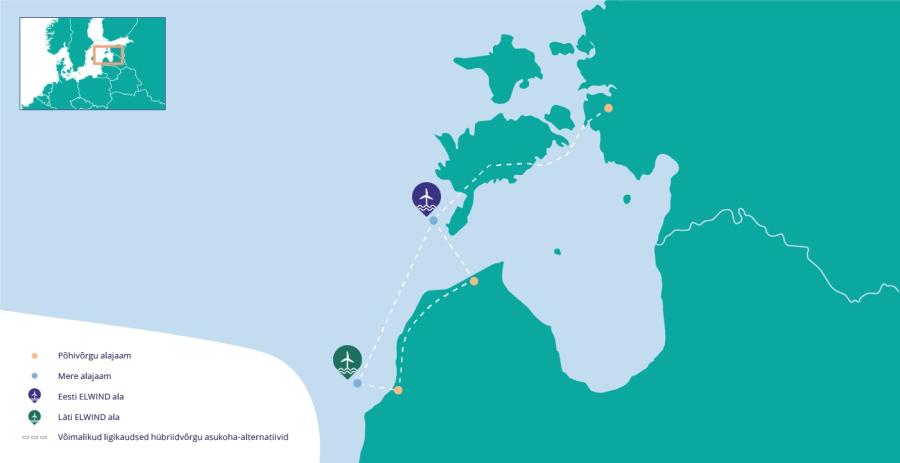For over a century, Estonia and Latvia have forged a history of cross-border cooperation, encompassing cultural exchanges, trade partnerships, and labor collaborations. In this Good Practice article, we underscore the significance of bolstering maritime spatial planning to ensure the implementation of large-scale offshore renewable energy projects. The ELWIND project stands as a stellar example of pioneering cross-border cooperation between two European Union member states, showcasing the unwavering commitment of neighboring countries to the advancement of renewable energy, with a specific focus on offshore wind power.
WHAT
On March 30, 2023, the European Commission proposed to revise the Renewable Energy Directive with the goal of raising the previously set target for renewable energy production from 40% to 42.5% by 2030.
On August 30, 2022, the Marienborg declaration was signed by eight European Union countries that share a border in the Baltic Sea. This declaration commits the signatory nations to increase their offshore wind power generation capacity by seven times, aiming to reach 20 gigawatts by 2030. The purpose of this initiative is to reduce dependence on Russian energy sources.
The ELWIND project fits as a response to those commitments. It is a collaborative effort between Estonia and Latvia in the field of offshore wind energy. Its primary objectives include enhancing energy independence in the region, expanding the production of renewable energy, and improving cross-border electricity connectivity. By increasing the offshore wind energy production capacity in Estonia and Latvia, the ELWIND project aims to contribute to the acceleration of green transition in Estonia and Latvia through cross-border cooperation. achieve the renewable energy targets.
The first stage of the project consists of studies and pre-development activities in order to ensure licensing to use specific maritime areas for wind energy production. The plan is to build two offshore wind parks, one in Estonian and one in Latvian waters with a total capacity up to 1 GW, but the final setup will be decided after an environmental impact assessment and other relevant studies.
The ELWIND project schedule foresees that all preparative studies will be completed, and the necessary construction permits agreed by 2026. Following that, the plan entails the organization of auctions for merchants willing to be involved in the future implementation of the project. 2030 is planned to be the deadline for project completion.
WHO
The governments of Latvia and Estonia initiated discussions for this project in 2019 that culminated in the signing of a Memorandum of Understanding to develop a 1 GW offshore wind farm in the Gulf of Riga. The initiative is now further developed by the Estonian Ministry of Economic Affairs and Communications, and the Latvian Ministry of Economics. The studies are coordinated by the Investment and Development Agency of Latvia (LIAA) and the Environmental Investment Centre in Estonia.
WHERE

Estonia and Latvia share a 343 km land border and a 214 km sea border. The Latvian research part of the ELWIND project will take place in the offshore wind park research area, located between Pāvilosta and Užava.
HOW
The Latvia-Estonia cross-border offshore wind project ELWIND is one of the first projects to have received approval for EUR 18.75 million funding as a Cross-Border Renewable Energy (CB RES) project of the Connecting Europe Facility Programme (CEF), created by the European Climate, Infrastructure and Environment Executive Agency (CINEA) with the goal of assisting the efficient delivery of the EU Green Deal.
RESULTS
- Green Energy Transition: By generating approximately 3TWh of electricity annually, ELWIND will meet 1/5 of Estonia and Latvia's total electricity consumption, equivalent to the combined annual consumption of both nations' transport sectors.
- Lower Energy Prices:ELWIND will contribute to lower and stabilized electricity prices by increasing supply and making large scale domestic green energy available
- Employment Generation: The operational lifetime of a wind park is around 25-30 years, which means the generation of employment in the cross-border regions for research, maintenance etc. Elsewhere in the world, different options are available for locals to benefit from wind parks, such as allowing local people to invest into wind energy themselves. Depending on developer’s approach these options could be discussed in the future.
Take a closer look at the project’s website: here
Here you can also read the Marienborg declaration.
- Effettua il login per postare commenti

